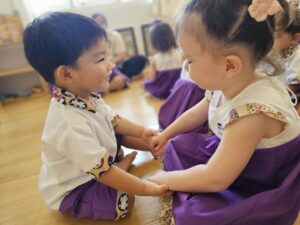Making and flying kites are wonderful family activities. Crafting kites with your children encourages creativity and imaginative thinking while flying them gets everyone moving and enjoying the outdoors. Kite-making is particularly enjoyable for children, as they can decorate simple kites, express their creativity, and engage in a fun, hands-on experience. Overall, making a kite with your child offers a blend of creativity, learning, and fun, while also providing an opportunity for meaningful bonding and skill development.
Did you know that kites have been used for many purposes, including scientific experiments, military applications, and as a hobby? For instance, Benjamin Franklin’s famous kite experiment demonstrated that lightning is a form of electricity. If you’ve been wondering how to make a kite, it’s an easy and engaging activity you can do at home with your child.
Benefits of Kite-Making
Kite-making is a fantastic activity for little ones, offering numerous developmental benefits alongside a creative outlet:
- Fine Motor Skills: Cutting, tying, and assembling a kite helps refine children’s fine motor skills and hand-eye coordination.
- Creativity and Self-Expression: Decorating the kite encourages children to express themselves artistically and explore different materials.
- Learning Through Play: Flying a kite introduces basic scientific concepts like wind, lift, and gravity in a fun and engaging way.
- Outdoor Exploration: This activity promotes outdoor play, an essential component of Montessori education, fostering a love for nature.
Step-By-Step Guide to Kite-Making
Materials Needed:
- Two lightweight wooden/bamboo sticks (one longer than the other)
- Paper or lightweight fabric (such as a plastic bag or tissue paper)
- String (for flying and to tie the sticks together).
- Tape or glue
- Scissors
Instructions:
- Form the Kite Frame: Cross the two bamboo sticks to form a “T” shape and tie them together securely at the center using a string. Make sure the shorter stick is positioned about one-third down the length of the longer stick.
- Create the Kite Sail: Lay your frame on a sheet of paper or fabric and trace around it, leaving an extra inch for folding. Cut out the sail and fold the edges over the frame, securing them with tape or glue.
- Attach the Flying String: Tie one end of a long piece of string to the center of the cross (the intersection of the sticks). This will be the string your child holds to fly the kite.
- Add a Tail (Optional): Cut a length of fabric or string and attach it to the bottom of the kite for stability. You can tie on small pieces of fabric or ribbon as bows for decoration.
Creative Ways to Personalise It
Now comes the fun part—decorating the kite! Encourage your child to use natural materials like leaves, flowers, or non-toxic paints to personalise their creation.
Here are a few Montessori-inspired decoration ideas:
- Natural Dyes: Use beet juice, turmeric, or spinach to create natural dyes and paint patterns on the kite.
- Nature Shapes: Cut out shapes like leaves, butterflies, or birds from coloured paper and glue them onto the kite for a nature-inspired theme.
- Textured Collage: Incorporate different textures by gluing on fabric, paper, or sand for a sensory-rich design.
Beyond Kite-Making
While kite-making is a fun and creative activity that you and your child can enjoy together, it also offers a wonderful opportunity to expand learning beyond the craft itself.
Take this experience a step further by incorporating lessons on creativity, problem-solving, science, and nature such as:
- Experiment with Shapes and Sizes: Make kites in different shapes (diamond, triangle, or dragon-shaped) and see which flies best. Discuss why some shapes perform better than others.
- Weather Exploration: Introduce a lesson on wind patterns and weather. Ask questions like, “Why does the kite fly better on windy days?” or “What happens if the wind stops?”
- Journal: Encourage your child to document their kite-making process, draw designs, and write about their experience flying the kite.
Ready, Set, Fly!
Next time, you can grab these kites on your trip to the beach and watch your little ones explore the winds with it!
Activities that involve hands-on crafting, nature exploration, and child-led creativity align perfectly with Montessori principles. Remember to encourage independence by allowing children to make choices, solve problems, and explore at their own pace. At House on the Hill, our emphasis is on letting children take the lead in their learning, with the right amount of support.
So gather your materials, get creative, and let your child’s imagination soar high in the sky!








